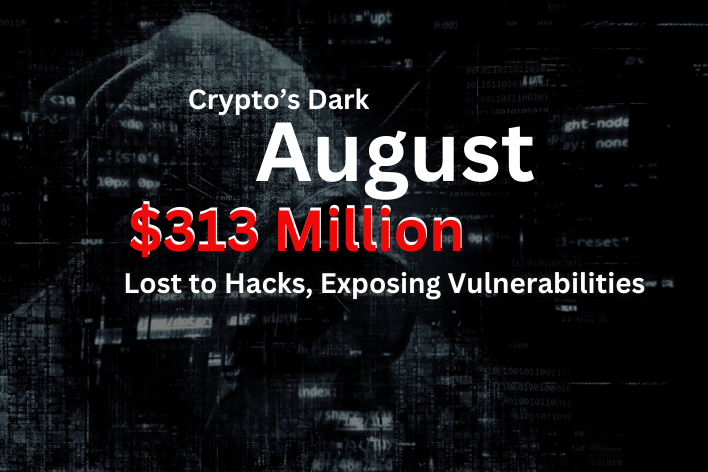Crypto’s Dark August: $313 Million Lost to Hacks, Exposing Vulnerabilities
Introduction:
August 2024 was a devastating month for the crypto market, with total losses exceeding $313 million due to a surge in hacks. Phishing attacks were the primary culprit, accounting for a staggering 93.5% of the total losses, roughly $293.4 million, highlighting a severe security gap in the industry. Major incidents, such as the $238 million theft of over 4,000 BTC from a Bitcoin whale and a $55.4 million DAI phishing heist, exposed how vulnerable even the most cautious crypto holders can be. Smart contract exploits, unauthorized transfers, and other security breaches contributed to the remaining losses, showcasing the diverse methods attackers used to target digital assets.
These staggering losses are not isolated incidents but part of a broader trend of escalating crypto attacks in 2024. So far, the industry has faced cumulative losses of $1.21 billion this year, reflecting the growing sophistication of cybercriminals and inherent vulnerabilities within blockchain technology. Beyond the financial toll, these breaches have eroded investor confidence, challenging the industry’s ability to secure its platforms and protect users. As crypto adoption accelerates, the urgency for enhanced security measures has never been more critical, raising serious questions about the industry's readiness to defend against evolving threats. This blog will explore the major hacks of August, analyze their impact, and discuss what they mean for the future of crypto security.
Deep Dive into Major Hacks
The most significant loss in August was the phishing attack on a Bitcoin whale, resulting in the theft of over 4,000 BTC, valued at approximately $238 million. The attackers employed sophisticated phishing techniques, tricking the victim into revealing private credentials through a deceptive website that mimicked a trusted crypto service. Once the attackers gained access, they swiftly moved the stolen BTC across multiple platforms, complicating recovery efforts and making it nearly impossible to trace the funds back to their original source.
Another major incident involved the theft of $55.4 million in DAI, which was swiftly converted to Ethereum. The attack targeted a large DAI holder who fell victim to a cleverly crafted phishing scheme, involving fake transaction alerts that led the victim to a malicious site. Once the hackers obtained the necessary credentials, they executed a rapid transfer and conversion process, ensuring the funds were quickly laundered through various decentralized exchanges. The speed and coordination of these attacks reveal the increasing sophistication of phishing tactics, posing a significant threat to the security of even the most vigilant crypto holders.
Other Notable Incidents
Alongside the major phishing attacks, several other significant breaches contributed to August’s $313 million in crypto losses. One of the key incidents was the “Ronin Network exploit”, where hackers managed to breach security protocols and siphon off millions. Although there was a partial recovery of funds, the total loss still amounted to several million dollars, showcasing the persistent threat of network vulnerabilities even after previous security upgrades.
Another notable attack was “Nexera’s smart contract manipulation”, which resulted in a $1.83 million loss. The hackers exploited flaws within the contract’s coding, allowing them to manipulate transactions and drain funds. This incident underscored the ongoing risks associated with decentralized finance (DeFi) platforms, where smart contract vulnerabilities can lead to substantial financial losses if not rigorously audited.
Additionally, there were several unauthorized transfers and smaller hacks, which collectively added to the overall damage. These included unauthorized withdrawals from compromised wallets and other minor breaches across various platforms. Although individually less impactful, these incidents collectively highlighted the widespread nature of crypto-related security issues, emphasizing the urgent need for improved protective measures across the industry.
Analysis of Security Implications
The surge in crypto losses due to hacks in August underscores critical security flaws within the industry. Phishing susceptibility remains a prominent vulnerability, as attackers exploit user negligence and inadequate security practices to gain unauthorized access to funds. Similarly, smart contract vulnerabilities continue to be a weak point, with flaws in the code enabling exploits that compromise the integrity of decentralized platforms. These breaches not only highlight the urgent need for robust security measures but also have a profound impact on the industry as a whole. Investor confidence is significantly shaken by such attacks, leading to a potential decline in market stability as stakeholders reassess the security of their investments. The long-term effects could manifest in stricter regulatory scrutiny and a shift towards more secure, but possibly less innovative, solutions.
Lessons Learned and Preventative Measures
The wave of crypto hacks serves as a crucial lesson for both institutions and individuals. For institutions, enhancing security protocols is paramount; this includes conducting regular audits to identify and address vulnerabilities and implementing advanced phishing detection systems to prevent attacks before they occur. Institutions should also foster a culture of security awareness among employees and stakeholders to bolster defenses against sophisticated threats. For individual crypto holders, adopting best practices can significantly mitigate risks. Utilizing hardware wallets ensures that private keys remain secure offline, while multi-factor authentication adds an extra layer of protection to online accounts. Staying vigilant against phishing scams—such as verifying the authenticity of communications and avoiding suspicious links—can prevent unauthorized access and safeguard assets. By following these recommendations, both institutions and individuals can fortify their defenses and contribute to a more secure crypto ecosystem.
Conclusion:
The recent surge in crypto-related hacks, culminating in losses exceeding $313 million in August, has exposed significant vulnerabilities within the industry, from phishing susceptibility to smart contract flaws. These incidents have not only shaken investor confidence but also highlighted the urgent need for enhanced security measures across the board. As we move forward, it is crucial for the crypto community to prioritize security, implementing stronger preventive measures and fostering a culture of vigilance. Institutions must strengthen their security protocols and conduct regular audits, while individuals should adopt best practices like using hardware wallets and multi-factor authentication. Looking ahead, the future of crypto security demands continuous innovation and vigilance to stay ahead of emerging threats. By collectively addressing these challenges, we can work towards a safer and more resilient crypto ecosystem.





